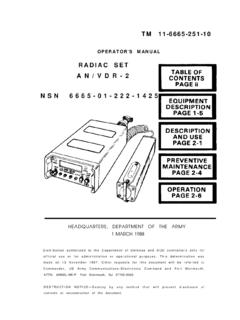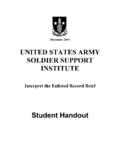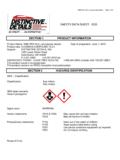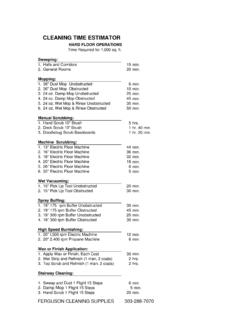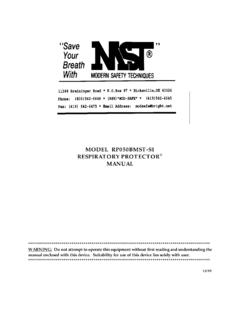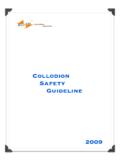Transcription of safe weapon handling - ChemicalDragon.com
1 6. Armorer responsibilities include:Verifying each individual s authority to bear arms before issuing any weapons , ammunition, or that each weapon is cleared and visually inspected prior to issue or all weapons shoulder gun stock assembly (butt) first, muzzle elevated, slide or bolt locked to the rear, and on only one person at a time to approach the issue and turn-in armorer or other authorized person must visually inspect all weapons , ensuring that all ammunition has been removed prior to Clearing barrels. The unloading and clearing of small arms and below that are not mounted to a vehicle will be accomplished in conjunction with a clearing barrel, when appropriate and available.
2 The commander must provide clearing barrels at designated clearing locations when required by local SOPs. Further guidance concerning construction, maintenance, and location of clearing barrels can be found in Air Force Manual 31-229. Clearing barrels will meet the following minimum standards:orientation will be enforced at all times, not just when the weapon is considered loaded. It is critical that Soldiers learn muzzle orientation as a life skill that becomes second nature and a personal will be kept on safe at all times when not engaging a target or when enemy contact is not imminent. Fingers will be kept off of the trigger until firing the weapon is intended.
3 There have been numerous accidental discharges resulting from Soldiers being bumped while the weapon safety selector was placed on FIRE and the finger on the will ensure that controls are in place to prevent Soldiers from mishandling weapons in living and sleeping will supervise weapons clearing at all times whether ammunition is present or not. Leaders will remain involved to ensure ammunition has not inadvertently been left in the weapon or placed in the weapon in a manner that can result in an accidental discharge. Leader enforcement of muzzle orientation is particularly important in these weapons handling clearing weapons on too ranges, the weapon will be oriented downrange during the clearing process.
4 When a clearing barrel is required by local installation SOPs, use the requirements as outlined in this memorandum. Commanders at all levels will ensure that a range safety Subject: safe weapons handling Procedures1. Accidental weapon discharges have increased at an alarming rate. These accidental discharges are both preventable and unacceptable. Commanders and leaders will enforce the standards for weapons safety, clearing procedures, and clearing barrels contained in this The premise that the Army is basing this standard on holds that there is no difference between unloading and clearing a weapon . Unloading a weapon is simply one step in the process of clearing.
5 At no time should a weapon be unloaded and not A significant number of accidents resulting in injuries and loss of life have been associated with accidental discharges during weapons cleaning or subsequent functional tests of the weapon with ammunition present. Leaders at all levels should not consider these activities low risk when ammunition is safe practices. safe muzzle orientation is critical to weaponssafety. Soldiers will always keep their weapon pointed in a safe direction. At no time should any part of the human body be in the likely path of a bullet. This requires constant awareness of the muzzle orientation and frequent repositioning and adjusting of the weapon .
6 Muzzle steps are posted, in a large format, adjacent to the clearing barrel. Each type of weapon will require its own description of the appropriate clearing procedures. Handheld laminated cards or checklists may be used in less permanent locations, such as in field sites. Arms Room Issue and Turn-in Clearing Barrel. Commanders will place, at a minimum, a 5-gallon container filled with pea gravel or dry sand inside the arms room. The 5-gallon barrel is not to be used for initial clearing, but rather as an additional safety step during issuing and turn-in of weapons . GSA-approved commercial containment systems (clearing barrels) for the type weapon system may be used in lieu of the constructed clearing barrels listed above.
7 They will be utilized and maintained IAW the manufacturers instructions. The requirement for annual inspection and clearing area standards will remain the Contingency deployments. While on contingency deployment theater commanders will establish strict guidance that addresses the following: Supervised weapons clearing. When ammunition is to be issued to Soldiers. When weapons are to be A 30-gallon container (drum) filled with pea gravel. Clearing barrels must be at least 14-inches wide and 24-inches deep. If dry sand is used (although pea gravel provides the greatest stopping ability) units will ensure the sand is kept dry and free of any debris. If the barrel is placed outdoors, place dry sand in a plastic bag and tie it off prior to placing it into the clearing barrel.
8 Clearing barrels will have a -inch plywood or thick rubber matting covering the diameter of the container and fitted directly behind the lid to reinforce it against muzzle blast. The barrel opening will have an aiming point in the center of the front lid at least 4-inches in diameter and 1 inch deep. The barrel will also have a tray with rubber matting affixed under the aiming point to prevent dropped rounds from falling to the ground. Maintenance. All clearing barrels must be checked annually to ensure maintenance of the construction standard. Document the annual check as part of a self-inspection program or in your safety book. Visually check barrels filled with pea gravel for settling, and refill as necessary.
9 Location and size. Units will assess each location and determine what size barrel best suits their needs. The clearing barrel will be mounted at a height and angle that permits safe and smooth firearms clearing. A 36-inch safety zone immediately surrounding the barrel will be marked on the ground or floor area with a red 4-inch line. Paint, colored tape, or colored tiles may be used to mark the 4-inch Commanders will ensure that clearing The placement of clearing barrels. Emplacement of clearing pits or designation of clearing lanes for mounted and crew-served weapons that account for the surface danger area of the system to be cleared. The frequency in which weapons are cleared.
10 Types of situations in which an officer or NCO is permitted to allow soldiers to place their weapons in a firing on contingency deployments, commanders will establish and publish standards that ensure weapons are cleared in a safe manner and in a safe location until clearing barrels constructed to standard are provided. Integrate clearing procedures into pre-deployment training at mobilization stations and combat readiness centers. Test firing of weapons will be strictly controlled by the chain of command under controlled conditions. A test-fire range will be set up during deployments, and controls placed and enforced by the forward operating base (FOB) or life support area (LSA) commander.

